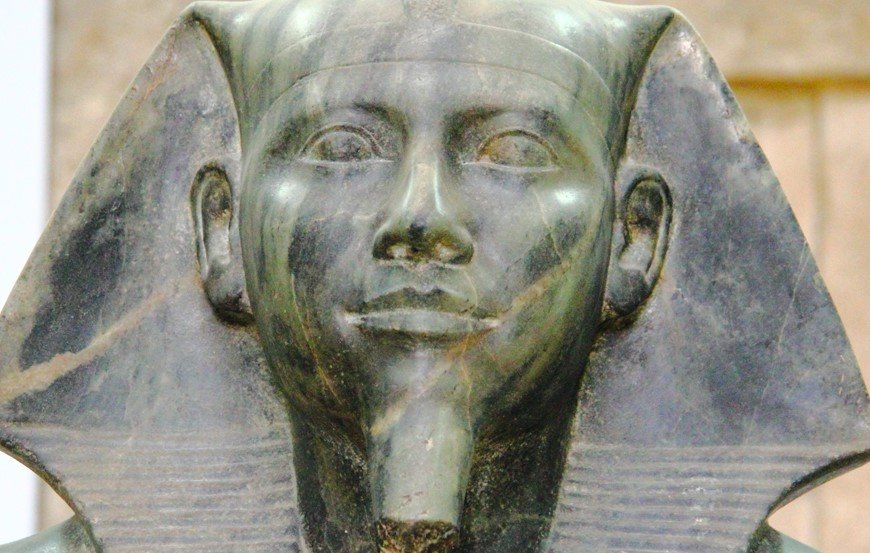A bust of an ancient Egyptian goddess, once dismissed as a clever fake due to its shiny surface and perfect nose, has now been proven authentic after detailed research. Experts confirmed this 2,500-year-old sculpture, crafted during the reign of Pharaoh Amasis II, as a true masterpiece worth about $2 million, set for display at a major UK art fair in 2025.
Initial Doubts at UK Auction
The story began in 2022 when the bust appeared at an auction in Gloucestershire, England. Collectors had kept it in a private collection for over 40 years, but its unusually pristine nose and glossy finish raised red flags. Many experts thought it was a high-quality imitation from a later era.
Auction attendees noticed the odd shine, which came from layers of wax and paint added over time. This led to low bids and skepticism. The piece sold for a fraction of its true value, as buyers worried about buying a forgery.
Recent checks showed the nose was a repair from the 18th century, done by Italian craftsmen. They used stone from the bust itself to make the fix look real. This clever work fooled people for centuries.
Rigorous Authentication Process
David Aaron, a leading antiquities dealer in London, took on the challenge in 2024. His team spent over a year on forensic tests, working with scientists, conservators, and Egyptologists. They used advanced tools like X-rays and chemical analysis to peel back the layers of history.

The investigation traced the bust’s origins to the Wadi Hammamat quarry in Egypt. Made from greywacke stone, it dates to 570-526 BC. Experts linked it to the Temple of Neith in Sais, a key religious site.
One key finding was ancient reworkings on the sculpture. In those times, artists often updated pieces for new rulers. This explained some unusual features that first seemed suspicious.
The team removed modern additions like wax and pigment during restoration. They kept the replacement nose, seeing it as part of the bust’s unique story. This “de-restoration” revealed the original serene features and detailed wig.
Historical Context and Significance
This bust represents a high point in ancient Egyptian art. Created by a sculptor known as the Greywacke Master, it shows expert skill in carving hard stone. The goddess likely depicts Neith, a warrior deity tied to creation and war.
During Amasis II’s rule, Egypt faced invasions, which may have damaged the piece. Persian forces under Cambyses II conquered Egypt in 525 BC, leading to widespread destruction of temples and statues.
Similar artifacts have fetched high prices at auctions. For example, a sculpture of the goddess Isis sold for over $5 million at Christie’s in 2012, setting records for Egyptian art.
The bust’s journey includes time on the Parisian art market in the 19th century. It highlights how ancient items moved through Europe during colonial times.
Experts say this piece stands among the finest Egyptian sculptures still in private hands. Its authentication adds to ongoing discussions about repatriation of artifacts to Egypt.
- Key features of the bust include a height of 24 cm and a striated wig design.
- It shows signs of iconoclasm, deliberate damage from ancient conflicts.
- The stone’s dark, smooth quality points to elite craftsmanship.
Restoration Challenges and Techniques
Restoring the bust was no simple task. Conservators faced layers of repairs from different eras. The 18th-century nose job used original stone, making it hard to spot as a fix.
Modern techniques helped separate fact from fiction. They analyzed pigments to date additions and confirmed the core as ancient.
One challenge was balancing preservation with authenticity. The team decided to rebuild using reversible methods, so future experts could adjust if needed.
This process mirrors efforts on other famous artifacts, like the Rosetta Stone, which also underwent cleaning to reveal details.
Market Value and Future Exhibition
Now valued at $1.5 million to $2 million, the bust has drawn interest from collectors worldwide. David Aaron plans to showcase it at Frieze Masters 2025 in London, a top event for ancient art.
This comes amid a booming market for authenticated antiquities. Sales at major houses like Christie’s and Sotheby’s hit record highs in 2024, driven by demand for pieces with clear provenance.
Buyers prize items with solid histories to avoid looting concerns. This bust’s documented path boosts its appeal.
| Timeline of the Bust’s History | Details |
|---|---|
| 570-526 BC | Carved during Amasis II’s reign at Temple of Neith. |
| 525 BC | Likely damaged during Persian invasion. |
| 18th Century | Restored with new nose by Italian craftsmen. |
| 19th Century | Appears on Parisian art market. |
| 1980s-2022 | Held in private UK collection. |
| 2022 | Sold at Gloucestershire auction amid doubts. |
| 2024-2025 | Authenticated and restored by David Aaron team. |
| 2025 | Exhibited at Frieze Masters in London. |
Broader Impact on Antiquities World
This authentication sheds light on how fakes and restorations can confuse experts. It encourages more rigorous checks in the art market.
Egypt has ramped up efforts to reclaim artifacts, with successes like returning a stolen coffin in 2023. While this bust remains in private hands, its story fuels debates on cultural heritage.
Collectors and museums now use tech like AI for verification, changing how ancient items are studied.
Share your thoughts on this fascinating discovery in the comments below. Did you know about similar ancient art stories? Spread the word by sharing this article with fellow history buffs.
